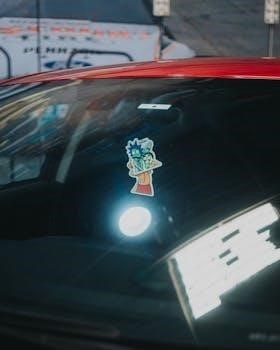
Hyundai Window Sticker PDF⁚ A Comprehensive Guide
This guide offers a comprehensive overview of Hyundai window stickers, also known as Monroney labels. We’ll explore their significance, the information they contain, and methods for obtaining a PDF copy, ensuring informed decisions when buying or researching a Hyundai vehicle.
Understanding the Hyundai Window Sticker (Monroney Label)
The Hyundai window sticker, formally known as the Monroney label, is a standardized document affixed to the window of every new Hyundai vehicle. This label serves as a comprehensive source of information about the car’s features, specifications, and pricing. Understanding the components of this sticker is crucial for buyers and enthusiasts alike.
It’s essentially a detailed breakdown of what the vehicle offers, directly from the manufacturer. This information is standardized, making it easier to compare different Hyundai models and trims. The Monroney label is not just a price tag; it’s a detailed summary of the car’s identity, including standard equipment, optional packages, and fuel economy ratings.
Whether you’re buying new or used, referencing the window sticker provides valuable insights into the vehicle’s original configuration and value. Many online tools and resources exist to help you decode this information, ensuring you have a full picture of your Hyundai’s features and history. This makes the Monroney label an invaluable tool for making informed purchasing decisions.

Why is the Hyundai Window Sticker Important?
The Hyundai window sticker, or Monroney label, holds significant importance for several reasons. Primarily, it serves as a transparent and reliable source of information about a vehicle’s original specifications and pricing. This is especially useful when purchasing a used car, allowing you to verify the features and options that were originally included.
The sticker ensures that you are aware of the vehicle’s original equipment, cost, and fuel economy. Without it, determining the precise configuration of a used Hyundai can be challenging, potentially leading to overpayment or disappointment with missing features. Dealerships may not always be able to provide this information readily, making the window sticker an essential tool for consumers.
It allows buyers to compare different models accurately and helps assess the vehicle’s value based on its original equipment and features. Furthermore, it provides a clear record of the manufacturer’s suggested retail price (MSRP), enabling informed negotiations and preventing potential price gouging. In essence, the window sticker empowers buyers with the knowledge needed to make confident and informed decisions.
Key Information Found on a Hyundai Window Sticker
A Hyundai window sticker is packed with vital information about the vehicle. At the top, you’ll find the manufacturer’s suggested retail price (MSRP), which is the base price of the car, excluding taxes, license fees, and dealer add-ons. It details the standard equipment included with the vehicle, such as engine specifications, transmission type, and safety features.
The sticker also lists any optional equipment and packages added to the vehicle, along with their individual prices. This is crucial for understanding the total cost of the vehicle when it was new. Fuel economy ratings, as determined by the EPA, are prominently displayed, providing estimates for city and highway mileage.
Furthermore, the window sticker includes the vehicle identification number (VIN), which is a unique identifier for the car. This is essential for tracking the vehicle’s history and verifying its specifications. Finally, the sticker often contains information about the vehicle’s warranty coverage and any applicable safety ratings. Examining these details allows for informed comparisons between different Hyundai models.
Where to Find Your Hyundai’s VIN
Locating your Hyundai’s Vehicle Identification Number (VIN) is a straightforward process. The most common location is on the driver’s side dashboard, visible through the windshield. Look for a small metal plate with a 17-character alphanumeric code. This is your VIN.
Another common location is on the driver’s side door jamb. Open the driver’s side door and examine the door frame, near where the door latches. You should find a sticker containing the VIN, along with other information such as tire pressure and vehicle weight ratings. It is critical to verify the VIN in multiple locations to ensure accuracy.
The VIN may also be found on your vehicle’s registration documents and insurance cards. These documents often display the VIN prominently for identification purposes. Accessing the VIN is essential for obtaining a Hyundai window sticker PDF, as it serves as the primary identifier for your vehicle. Keep in mind that the VIN is a unique code specific to your car.
Methods for Obtaining a Hyundai Window Sticker PDF
Several methods exist for obtaining a Hyundai window sticker PDF. One popular approach is to utilize the MyHyundai website or app. If you have an account and your Hyundai is registered, the window sticker may be available under the “My Vehicles” section, often within “My Account.” This method provides a direct link to your vehicle’s information.
Online window sticker lookup tools are another readily available option. Numerous websites specialize in generating window stickers using the VIN. Simply enter your VIN into the tool, and it will attempt to retrieve the original Monroney label. Some of these tools are free, while others may charge a fee for the service. Be sure to research the tool’s reputation and data accuracy before using it.
If you are unable to locate the window sticker online, contacting a Hyundai dealership may be necessary. Although dealerships are not always able to provide it, especially for older vehicles, they may have access to historical records.
Using the MyHyundai Website/App
The MyHyundai website and app are valuable resources for Hyundai owners, offering a range of services, including the potential to access your vehicle’s original window sticker. To leverage this method, you’ll first need to register for an account on the MyHyundai platform. This typically involves providing your vehicle’s VIN and some personal information to verify ownership.
Once logged in, navigate to the “My Vehicles” section, which can usually be found under the “My Account” tab. Within this section, look for options related to vehicle information or documents. The window sticker, if available, may be listed as a downloadable PDF. Keep in mind that the availability of the window sticker on MyHyundai can depend on the vehicle’s model year and how long ago it was sold.
If you encounter any difficulties, the MyHyundai customer support team can assist you in locating the window sticker or exploring alternative options.
Utilizing Online Window Sticker Lookup Tools
Several online tools are available that claim to offer Hyundai window stickers based on the Vehicle Identification Number (VIN). These services act as search engines, scanning databases to locate the original Monroney label associated with a specific VIN. To use these tools, simply enter the VIN into the designated field and initiate the search.
Some popular online window sticker lookup tools include websites like Wikilender and Detailed Vehicle History, which are known for their ability to generate window stickers. There are also other sites that will generate window stickers for you after entering the VIN. While convenient, it’s essential to exercise caution when using these services. Verify the tool’s credibility and ensure that the website is secure before entering your VIN or any personal information.
Additionally, be aware that some tools may charge a fee for accessing the window sticker, while others offer it for free. Compare multiple tools to find the most reliable and cost-effective option.
Free vs. Paid Window Sticker Services
When searching for a Hyundai window sticker PDF online, you’ll encounter both free and paid services. Free services often rely on advertising or limited access to databases, which can result in inaccurate or outdated information. These services may provide a basic window sticker but lack the detailed information found on the original Monroney label.

Paid services, on the other hand, typically offer more comprehensive and reliable data. They invest in maintaining extensive databases and verifying the accuracy of the information provided. While requiring a fee, these services often guarantee access to the original window sticker, including all factory-installed options, standard equipment, and pricing details. The fee ensures higher accuracy and more detailed information, making it a worthwhile investment when needing precise data.
The choice between free and paid services depends on your specific needs and budget. If you require a quick overview, a free service might suffice. However, for detailed and accurate information, a paid service is the recommended option.
Potential Issues with Salvage Vehicles and Window Stickers
When dealing with salvage vehicles, obtaining an accurate window sticker can be challenging. A salvage title indicates that the vehicle has been declared a total loss by an insurance company due to damage or theft. This can significantly impact the availability and accuracy of the original window sticker information.
Often, salvage vehicles undergo repairs or modifications that deviate from the original factory specifications. These alterations may not be reflected in the original window sticker, leading to discrepancies between the sticker’s information and the vehicle’s actual condition; For example, the vehicle may have had parts replaced, options removed, or upgrades installed that were not present when it originally left the factory.
Furthermore, the original window sticker might be lost or damaged during the salvage process. While it’s still possible to obtain a window sticker using the VIN, the information may not accurately represent the vehicle’s current state. It is crucial to thoroughly inspect salvage vehicles and verify any modifications independently to ensure the sticker’s accuracy.
Decoding Hyundai VIN Details
The Vehicle Identification Number (VIN) is a unique 17-character code assigned to every Hyundai vehicle. Decoding the VIN provides valuable insights into the vehicle’s origin, specifications, and features. Each character within the VIN represents specific information, such as the manufacturer, country of origin, vehicle type, engine type, and assembly plant. Understanding the VIN structure allows you to verify the accuracy of the information presented on the window sticker.
The first three characters identify the manufacturer and country of origin. Characters four through eight describe the vehicle’s body style, engine type, and other specifications. The ninth character is a check digit used to verify the VIN’s authenticity. The tenth character indicates the model year, while the eleventh character identifies the assembly plant. The last six characters are the vehicle’s serial number, providing a unique identifier within the production run.
By using online VIN decoders or consulting Hyundai resources, you can decipher the VIN to confirm the vehicle’s specifications and ensure they align with the details provided on the window sticker. This process helps verify the vehicle’s history and identify any potential discrepancies or inconsistencies.
What to Do if the Dealership Can’t Provide a Window Sticker
If a dealership is unable to provide the original window sticker for a Hyundai vehicle, don’t be discouraged. Several alternative methods can help you obtain the necessary information. Start by requesting the VIN from the dealership. With the VIN, you can utilize online window sticker lookup tools or access the MyHyundai website/app to potentially retrieve a digital copy of the sticker.
If these methods prove unsuccessful, consider contacting Hyundai directly or exploring third-party services that specialize in obtaining vehicle information. Some online services offer Monroney label retrieval based on the VIN, although fees may apply. Remember to exercise caution when using third-party services and verify their legitimacy before providing any personal or vehicle information.
In some cases, the dealership may be able to provide a build sheet or vehicle specifications report, which contains similar information to the window sticker. While not an exact replacement, this document can offer valuable details about the vehicle’s original equipment and features. Persistence and utilizing available resources can often lead to uncovering the desired information.
Benefits of Knowing the Original Equipment and Cost
Understanding a Hyundai’s original equipment and cost, as detailed on the window sticker, offers numerous advantages. Primarily, it ensures transparency and informed decision-making when purchasing a used vehicle. By verifying the factory-installed features and options, you can confirm the accuracy of the seller’s claims and avoid potential discrepancies. This knowledge is crucial in assessing the vehicle’s value and negotiating a fair price.
Furthermore, the window sticker reveals the original MSRP (Manufacturer’s Suggested Retail Price), providing a benchmark for comparing the current asking price. This information helps you gauge depreciation and assess whether the vehicle is priced competitively within the market. Knowing the original equipment also aids in identifying any aftermarket modifications or additions, allowing you to evaluate their impact on the vehicle’s overall value and performance.
Moreover, the window sticker can be invaluable for insurance purposes and future maintenance. It provides a comprehensive record of the vehicle’s specifications, which can be essential when obtaining insurance quotes or ordering replacement parts. Access to this information ensures you have a complete understanding of your Hyundai’s features and value, empowering you to make informed decisions throughout its ownership.
Example of a Hyundai Window Sticker
Visualizing a Hyundai window sticker helps understand the information it presents. Typically, at the top, you’ll find the manufacturer’s information, including the Hyundai logo and corporate details. The vehicle’s specific information, such as the model year, make, and trim level, are prominently displayed, along with the VIN (Vehicle Identification Number), which is crucial for vehicle identification and history checks. The sticker clearly outlines the standard equipment included with the vehicle, from safety features to interior amenities.

A significant portion of the sticker is dedicated to listing optional equipment and packages added to the base model. Each option is described with its corresponding price, contributing to the vehicle’s total MSRP. Fuel economy ratings, as determined by the EPA, are also displayed, providing estimates for city and highway driving. These figures help potential buyers assess the vehicle’s fuel efficiency and estimated annual fuel costs.
Finally, the bottom of the sticker often includes disclaimers, assembly point information, and a QR code that can be scanned for digital access to the window sticker details. Reviewing a sample sticker provides a clear framework for understanding the various components and data points, enabling informed decisions when evaluating a Hyundai vehicle. It acts as a complete overview of the cars original specifications.


